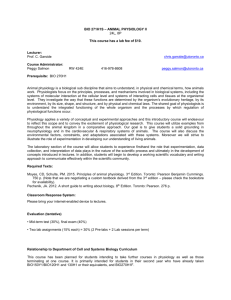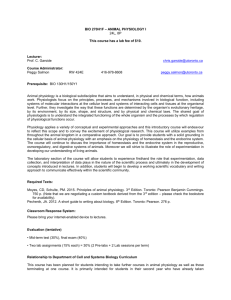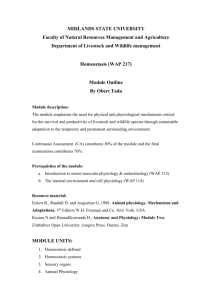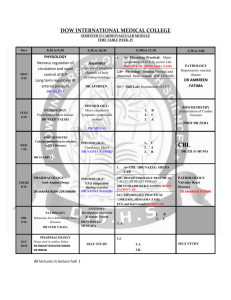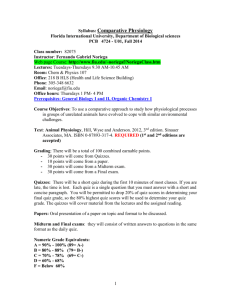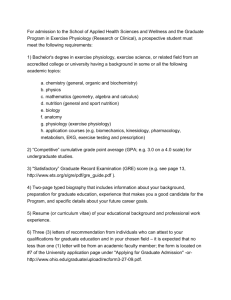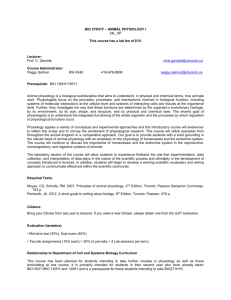I have found that teaching students is one of the most satisfying parts
advertisement
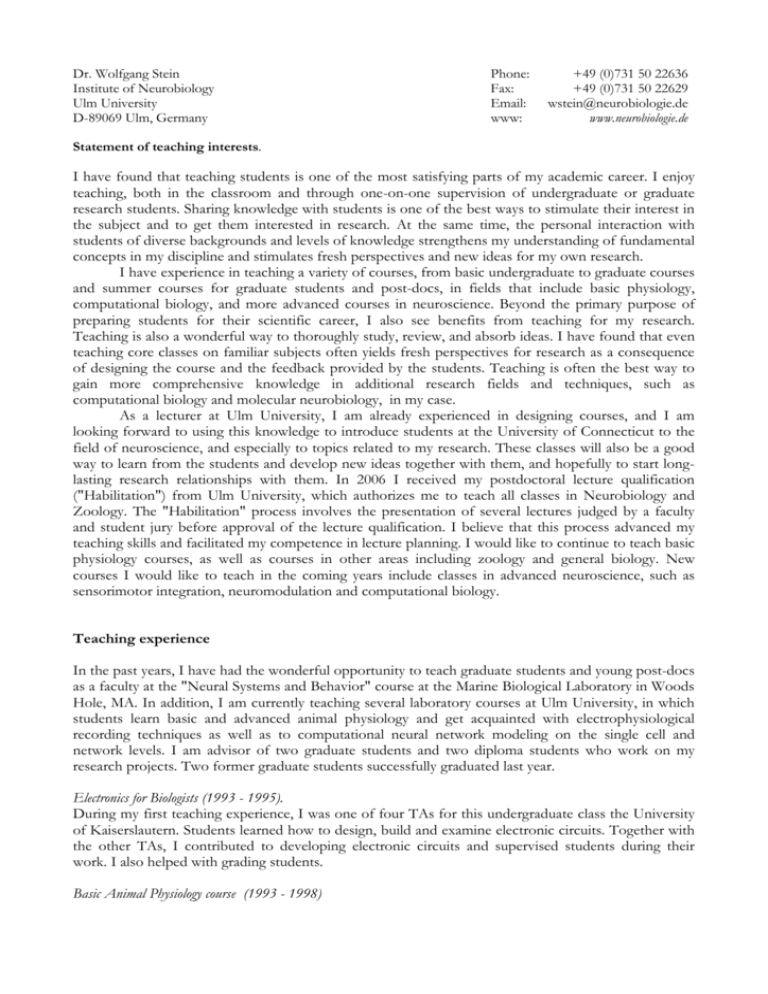
Dr. Wolfgang Stein Institute of Neurobiology Ulm University D-89069 Ulm, Germany Phone: Fax: Email: www: +49 (0)731 50 22636 +49 (0)731 50 22629 wstein@neurobiologie.de www.neurobiologie.de Statement of teaching interests. I have found that teaching students is one of the most satisfying parts of my academic career. I enjoy teaching, both in the classroom and through one-on-one supervision of undergraduate or graduate research students. Sharing knowledge with students is one of the best ways to stimulate their interest in the subject and to get them interested in research. At the same time, the personal interaction with students of diverse backgrounds and levels of knowledge strengthens my understanding of fundamental concepts in my discipline and stimulates fresh perspectives and new ideas for my own research. I have experience in teaching a variety of courses, from basic undergraduate to graduate courses and summer courses for graduate students and post-docs, in fields that include basic physiology, computational biology, and more advanced courses in neuroscience. Beyond the primary purpose of preparing students for their scientific career, I also see benefits from teaching for my research. Teaching is also a wonderful way to thoroughly study, review, and absorb ideas. I have found that even teaching core classes on familiar subjects often yields fresh perspectives for research as a consequence of designing the course and the feedback provided by the students. Teaching is often the best way to gain more comprehensive knowledge in additional research fields and techniques, such as computational biology and molecular neurobiology, in my case. As a lecturer at Ulm University, I am already experienced in designing courses, and I am looking forward to using this knowledge to introduce students at the University of Connecticut to the field of neuroscience, and especially to topics related to my research. These classes will also be a good way to learn from the students and develop new ideas together with them, and hopefully to start longlasting research relationships with them. In 2006 I received my postdoctoral lecture qualification ("Habilitation") from Ulm University, which authorizes me to teach all classes in Neurobiology and Zoology. The "Habilitation" process involves the presentation of several lectures judged by a faculty and student jury before approval of the lecture qualification. I believe that this process advanced my teaching skills and facilitated my competence in lecture planning. I would like to continue to teach basic physiology courses, as well as courses in other areas including zoology and general biology. New courses I would like to teach in the coming years include classes in advanced neuroscience, such as sensorimotor integration, neuromodulation and computational biology. Teaching experience In the past years, I have had the wonderful opportunity to teach graduate students and young post-docs as a faculty at the "Neural Systems and Behavior" course at the Marine Biological Laboratory in Woods Hole, MA. In addition, I am currently teaching several laboratory courses at Ulm University, in which students learn basic and advanced animal physiology and get acquainted with electrophysiological recording techniques as well as to computational neural network modeling on the single cell and network levels. I am advisor of two graduate students and two diploma students who work on my research projects. Two former graduate students successfully graduated last year. Electronics for Biologists (1993 - 1995). During my first teaching experience, I was one of four TAs for this undergraduate class the University of Kaiserslautern. Students learned how to design, build and examine electronic circuits. Together with the other TAs, I contributed to developing electronic circuits and supervised students during their work. I also helped with grading students. Basic Animal Physiology course (1993 - 1998) As a diploma student at the University of Kaiserslautern I co-taught recitations with two other diploma students. I was responsible for dissections of animals and supervising students during the course, and I took part in designing and grading exams. Advanced Animal Physiology Course (1995 – 1998) As a graduate student at the University of Kaiserslautern I was the sole TA for this course. I conducted recitations which were attended by post-docs and faculty listening to the class. I enjoyed autonomy in preparing these recitations, identifying and developing topics to be covered. Together with a post-doc, I developed and performed the animal dissections and the computer models of the studied neuronal networks. Animal Behavior Course (2001-2007) After my first post-doc, I started to teach this core undergraduate course as a faculty at Ulm University. In this course, students are introduced to different animals models used in neurobiology and to different methods for investigating animal behavior. Emphasis is clearly on animal behavior. I was involved in designing this course, in supervising TAs and for teaching students. Basic Animal Physiology course (2000 – 2007) I served as a lecturer, together with Prof. Wolf, preparing and delivering parts of the lectures and cosupervising the TAs. This mandatory class introducing the physiology of a broad spectrum of animals to the students is the largest class I have been involved with, with over 120 students, and a combined staff of over ten instructors and TAs. Methods in Neurobiology (2001 - 2007) I am involved in designing this advanced diploma course at Ulm University. Being responsible for teaching students the skills needed for electrophysiological recordings, I supervise TAs and serve as a lecturer for the participating students. In this course, I introduce small groups of students (2 - 3 students each) to my research by letting them participate in demonstration experiments on the rig. Advanced Animal Physiology Course (2000 – 2007) In this course, students work for several weeks on small research projects in my lab. I serve as a lecturer and contact person for all student questions. I am solely responsible for supervising my two TAs (usually my two graduate students) and for providing students with ideas for new projects. Projects are then developed together with the students. Besides electrophysiological recordings, this course also includes advanced computer modeling of neuronal networks. Seminar Advanced Animal Physiology (2000 – 2007) In support of the advanced Animal Physiology course, I organize a seminar together with three other faculty at Ulm University. In this seminar, students present current research publications and their own results obtained during the Physiology course. Neural Systems & Behavior (2002 - 2007) This is an intensive eight-week laboratory and lecture course at the Marine Biological Laboratory in Woods Hole, MA, focusing on the neural basis of behavior. Graduate students and young post-docs are being introduced to a variety of animal models used in neuroscience. I served as a faculty and lecturer, and was involved in planning and designing the experiments for the students in our cycle (two weeks; usually eight students; supervised by three to four faculty). Zoom into Science program (2007). This program introduces school children (eleven to two years old) to scientific life and the research at Universities. I participated by planning, performing and supervising basic physiology experiments, such as electromyographic recordings from face muscle during laughing. Teaching philosophy The opportunity for personal interaction with students of diverse backgrounds and levels of knowledge is one of the main reasons why I am attracted to the academic environment. This interaction not only stimulates the students’ interest in the subject, but also gets them interested in research. I believe that providing research opportunities for more advanced students gives them the extra challenges they need in order to stay motivated. My teaching experience convinced me that it is difficult for students to learn, retain, and apply information if they are not interested in the course material. I thus strive to present to them as many connections as possible between course material and everyday life. For example, when teaching sense organs, I try to connect concepts taught in the class to sensory phenomena that students experience during the class (such as auditory input) or on their way to school (such as visual input when they drive a car). I recognized that not all students enter a given class with the same background, nor do they all share the same approach to studying. Thus, I have found that teaching is most effective when the selection of material and its presentation are tailored to the audience. This involves a greater emphasis on fundamental concepts and definitions, or a greater number of examples from “real world” applications. In addition, I believe that it is important to be approachable for students. This attitude benefits me in the classroom and encourages me to provide different approaches to teach the same concepts. In all my classes and laboratory courses, I use student course handouts which can easily be tailored to a specific audience, providing students with a complete and succinct discussion of the course material in one source, rather than several incomplete textbooks. Naturally, I expect students to gain alternative approaches and perspectives on the course material by reading accompanying text books. I am convinced that one of the best ways to get students interested in research and scientific work is to involve them in small groups in laboratory projects. Working in a scientific environment, rather than a class room, motivates advanced students and introduces to them the process of scientific investigations. In addition, such laboratory courses provide the opportunity for the students to personally get to know their teachers and to learn about the associated research topics, and they allow teachers to spend more time with potential candidates for future research projects.


